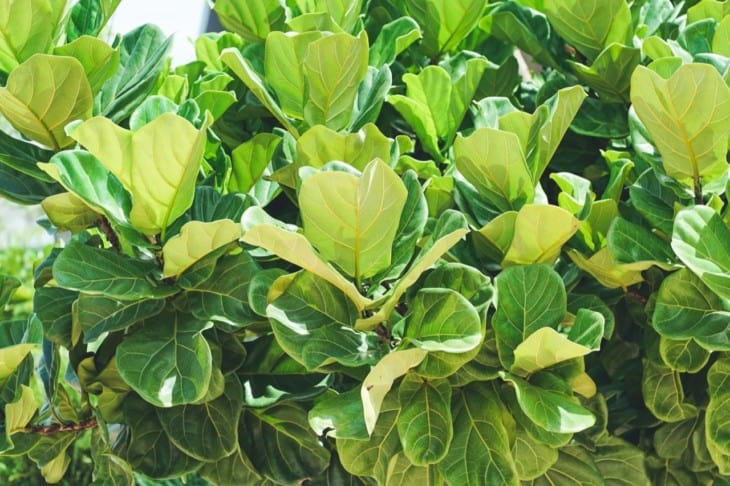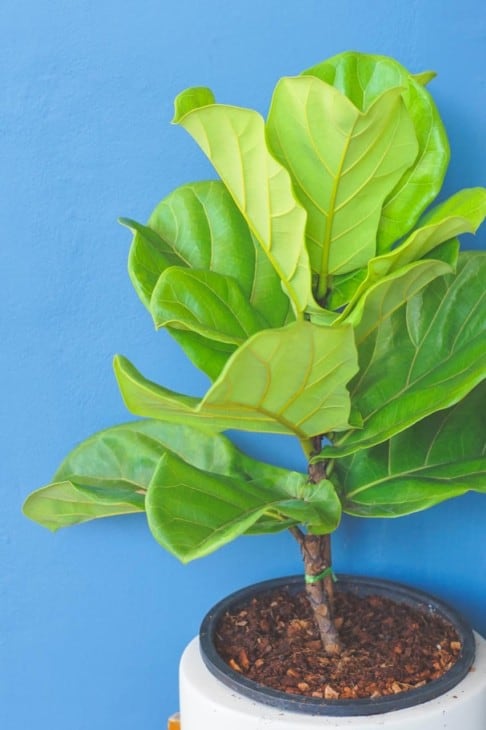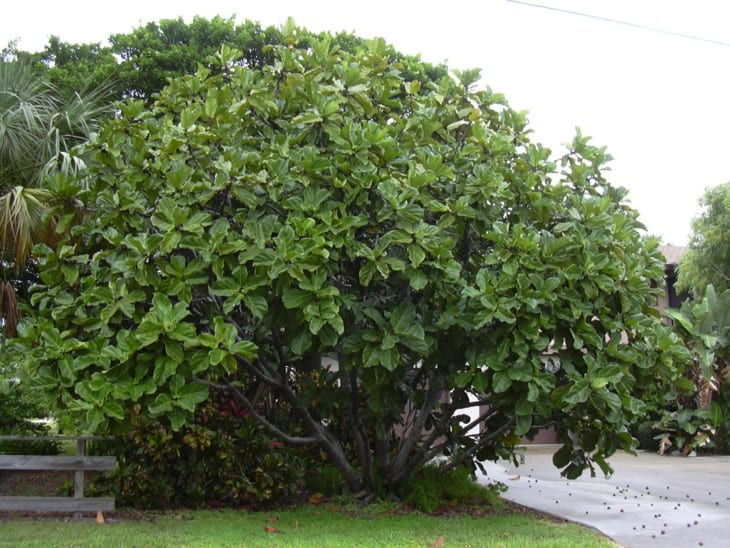The fiddle leaf fig tree (Latin name: Ficus lyrata) is a wildly popular indoor plant and has been for years. It has large, striking, fiddle-shaped leaves situated at the top of a slender stem. The tree can grow up to ten feet tall when grown indoors and fifty feet outdoors. Besides their decorative advantages, fiddle leaf fig trees provide several benefits when grown indoors.
Contents
Fiddle leaf fig trees clean the air, removing toxic chemicals such as ammonia resulting in healthy air for us to breathe. The large green leaves are calming, reduce stress and blood pressure, and improve concentration. Caring for plants can add meaning to people’s lives.
The fiddle leaf fig tree originates from West African tropical rain forests and is sometimes called the banjo fig. The beauty of this tree is found in the leaves and it does not bear any fruit or flowers.
Related:
– The Many Rubber Tree Benefits For Health
– Ficus Tree (Weeping Fig) Benefits
1. The Fiddle Leaf Fig Tree Cleans The Air

Fiddle leaf figs photosynthesize rapidly, making them excellent at producing oxygen, which improves the air quality. In addition, studies have found that fiddle leaf figs are ideal plants for absorbing toxic chemicals such as ammonium, formaldehyde, and benzene.
A NASA study completed by B.C. Wolverton found that plants were more efficient at cleaning the air than any technology that NASA had designed. Fiddle leaf fig trees have huge leaves – each leaf measures about twelve inches long.
These big leaves allow them to respire and photosynthesize rapidly, producing large quantities of oxygen. As fiddle leaf fig trees photosynthesize, they absorb toxic gases and carbon dioxide that make the air unhealthy to breathe.
The plant roots draw environmental air into the soil. Microbes in the fiddle leaf fig roots filter toxic chemicals while absorbing oxygen for the plant’s use.
2. The Fiddle Leaf Fig Trees Aids With Sick Building Syndrome

The interesting phenomenon described as sick building syndrome is commonly seen in new or refurbished buildings. These buildings are freshly painted, carpets are stuck with glue, and many other chemicals are used in the construction, finishing, and decorating. These chemicals begin off-gassing – they give off noxious fumes, which are detrimental to the occupants’ health.
The fumes in sick building syndrome irritate the mucus membranes of the throat, nose, lungs, and eyes. The irritation results in inflammation and infection of the sinuses, lungs, throat, and eyes.
Many people experience persistent coughs and blocked noses due to sick building syndrome. The fumes can also result in fatigue, mental fog, inability to concentrate, and depression.
Fiddle leaf fig trees have large leaves that are well equipped to clean the air in sick buildings. Many building owners routinely include plants such as fiddle leaf fig trees in buildings. Tenants and people who live or work in newly refurbished or new buildings buy their own fiddle leaf fig trees to improve their health.
Should I Have More Than One Fiddle Leaf Fig Tree?
Researchers have determined that in order to clean the air effectively, there should be two to three plants per hundred square feet of building space. The benefit of using a fiddle leaf fig tree is that the large leaf size allows one fiddle leaf fig to count as three to five smaller plants.
In a 1500 square feet home, you would need thirty to forty-five smaller plants. If you use fiddle leaf fig trees, you need only six to nine plants.
3. The Psychological Benefits Of Fiddle Leaf Fig Trees

Psychological studies have shown that being surrounded by nature is essential for mental health. It isn’t easy for some people who live in cities or work in buildings to get out into the great green natural world outside. The next best option is to bring the greenery inside.
Fiddle leaf figs grow well in indirect light, making them suitable as indoor plants. Their large lush, bright green leaves change the room’s ambiance, resulting in a calmer, more peaceful; environment.
Studies have shown that having plants, including fiddle leaf fig trees, helps people concentrate and improves mental focus. Productivity improves by fifteen percent in rooms containing plants. This factor has important implications for using plants in offices, study rooms, and classrooms.
The psychological benefits of fiddle leaf fig trees extend to physical well-being. They have been shown to reduce stress and high blood pressure.
Do Fiddle Leaf Fig Trees Help With Depression?
Fiddle leaf fig trees, along with other plants, have been shown to lift moods and create a more positive attitude in people who suffer from depression. It is suggested that the additional oxygen in rooms containing plants may also help counteract depression.
Many people have become isolated due to the need to live in cities near work. They live alone with little contact with family, and increasingly longer work hours result in situations where there is minimal psychological support. COVID-19 lockdowns have worsened the isolation that many people feel.
Isolation is a critical factor in causing depression. Some psychologists have found that the simple act of caring for a plant can give someone a reason for living and reduce the feeling of isolation. Fiddle leaf fig trees require a fair amount of attention, which makes them ideal for someone who wants a plant for this reason.
People interested in caring for their fiddle leaf fig tree are also more likely to join online forums and connect with people with similar interests. This online interaction also helps to alleviate loneliness and allows the person to form connections.
4. Fiddle Leaf Fig Trees Are Excellent for Décor And Landscaping

Fiddle leaf fig trees are not plants that are overlooked. Their massive size demands attention. They can be used to enhance décor in a room and create specific effects. They can be clipped or trimmed at the top to create bushier plants, or you can choose a cultivar with the features you require.
Fiddle leaf fig trees can be grown outside where their large size and huge leaves create structure and form in a garden. They can also be used as understory plants in parks or more extensive gardens where a more thickly vegetated area is planned.
Conclusion
Fiddle leaf fig trees are excellent for cleaning the air and treating sick buildings. Their extravagant green leaves help change a mood, assist with concentration and improve productivity. They are valuable plants in decor and garden planning.







